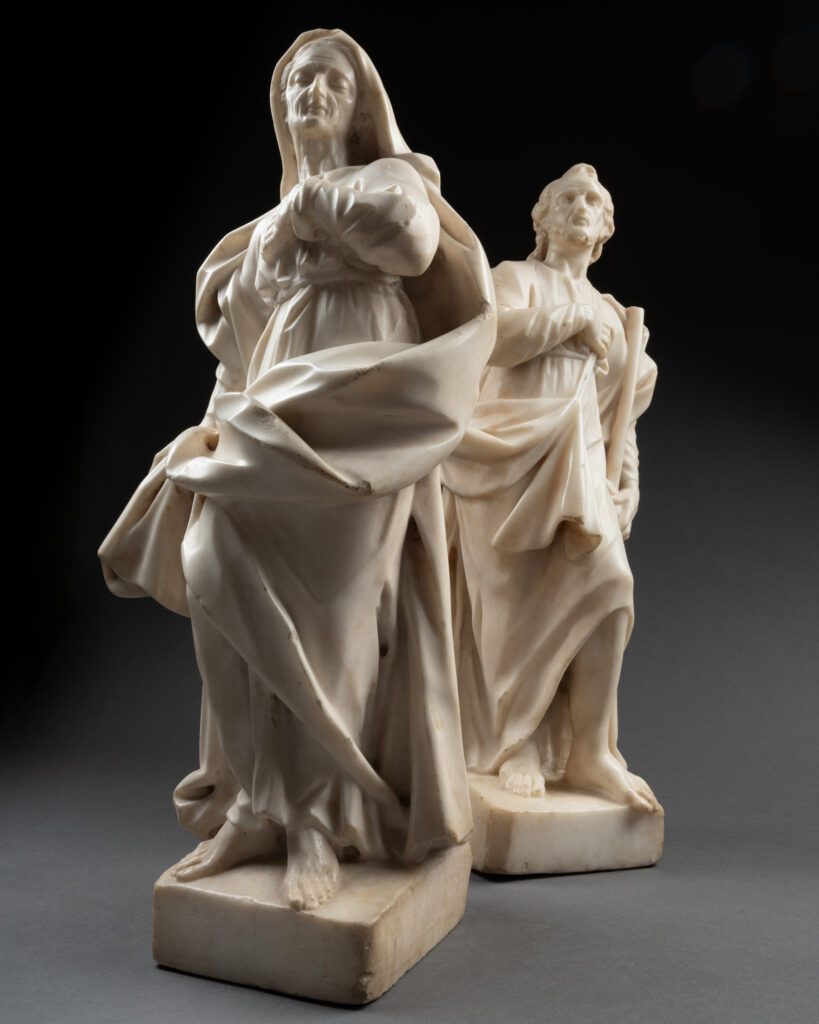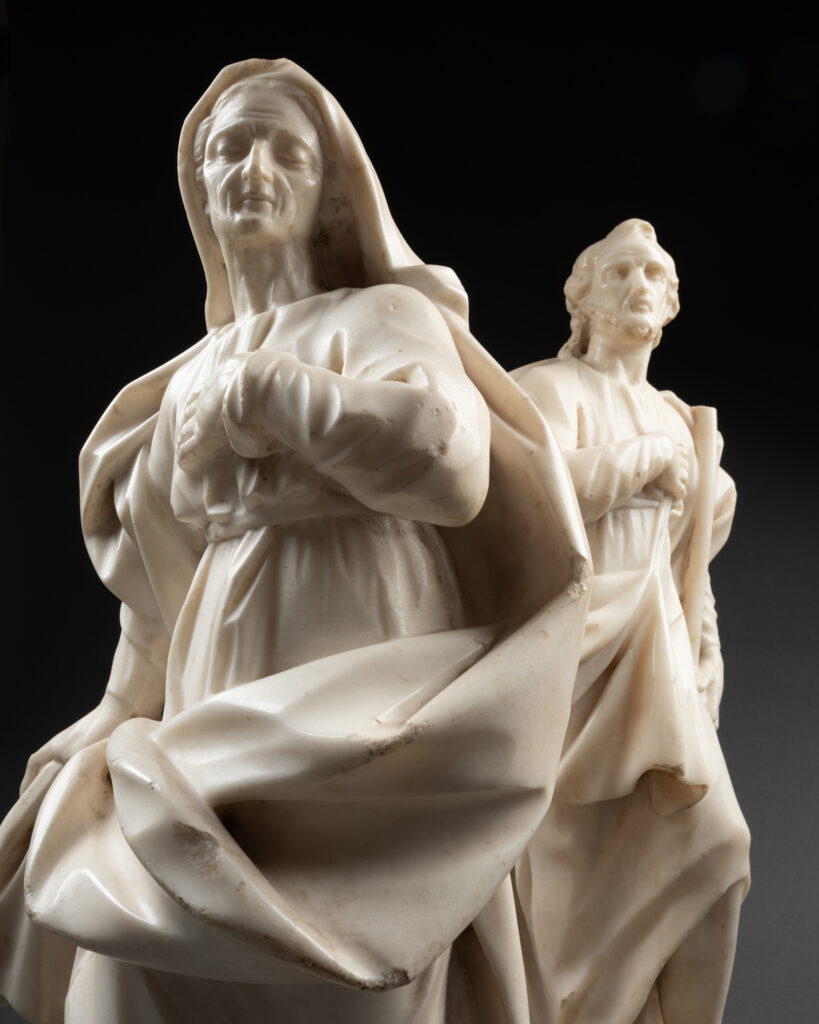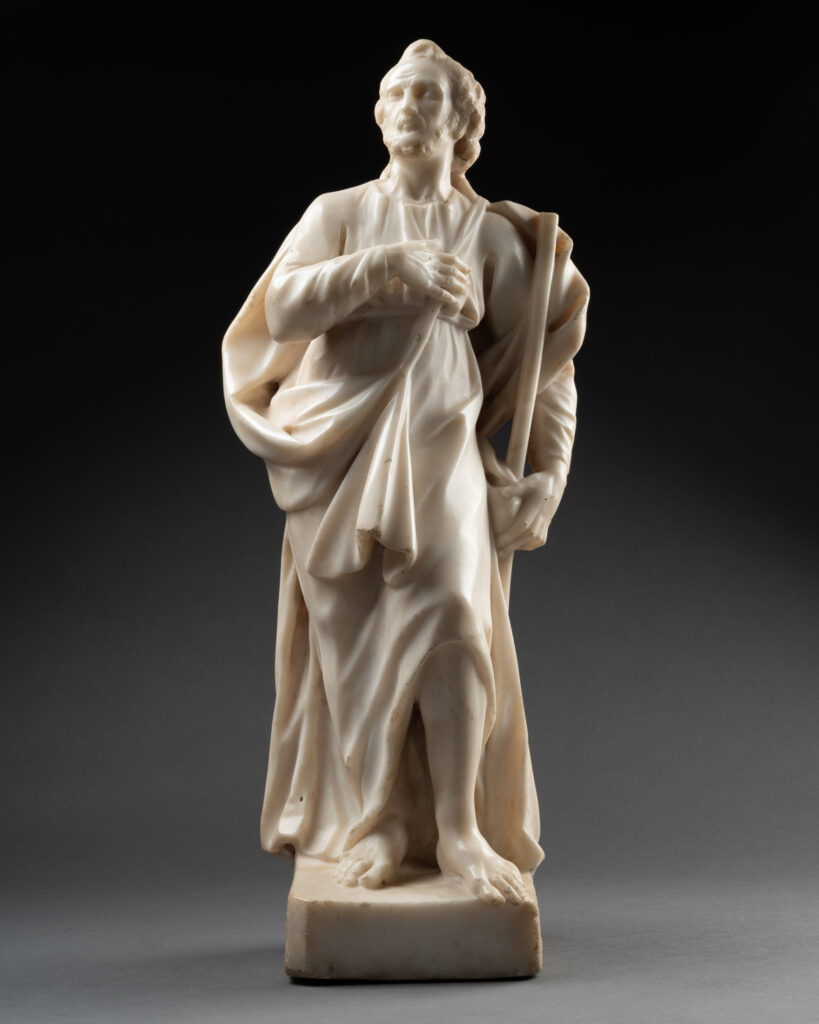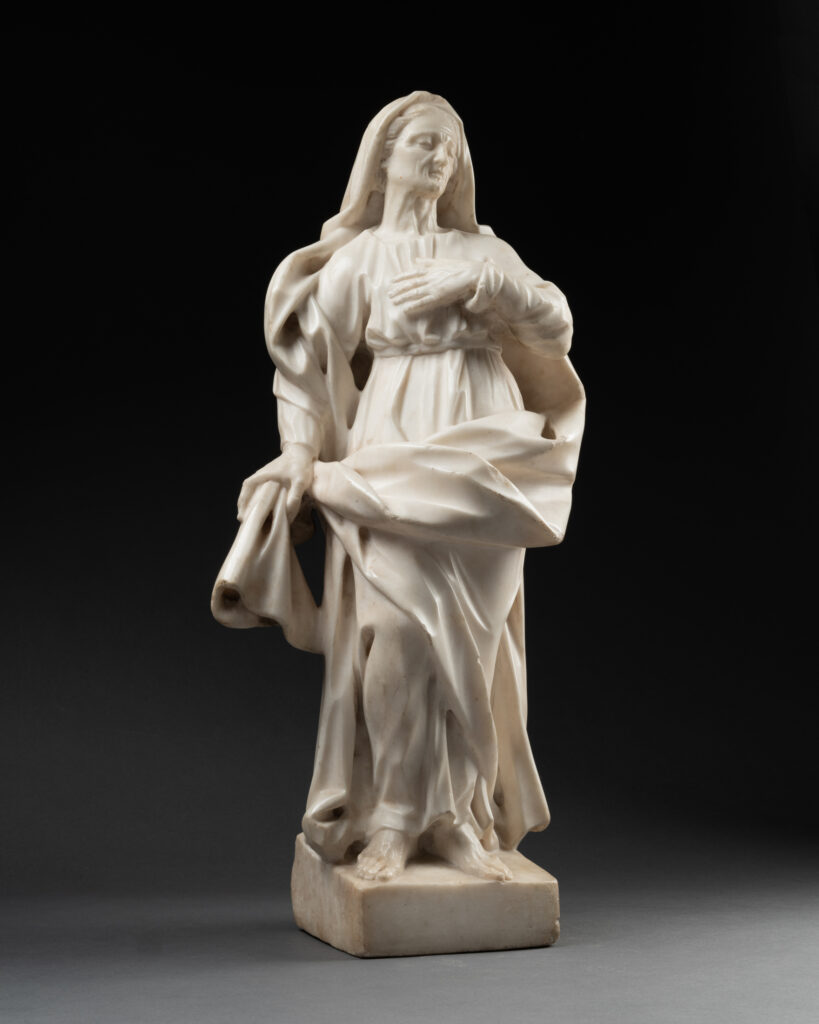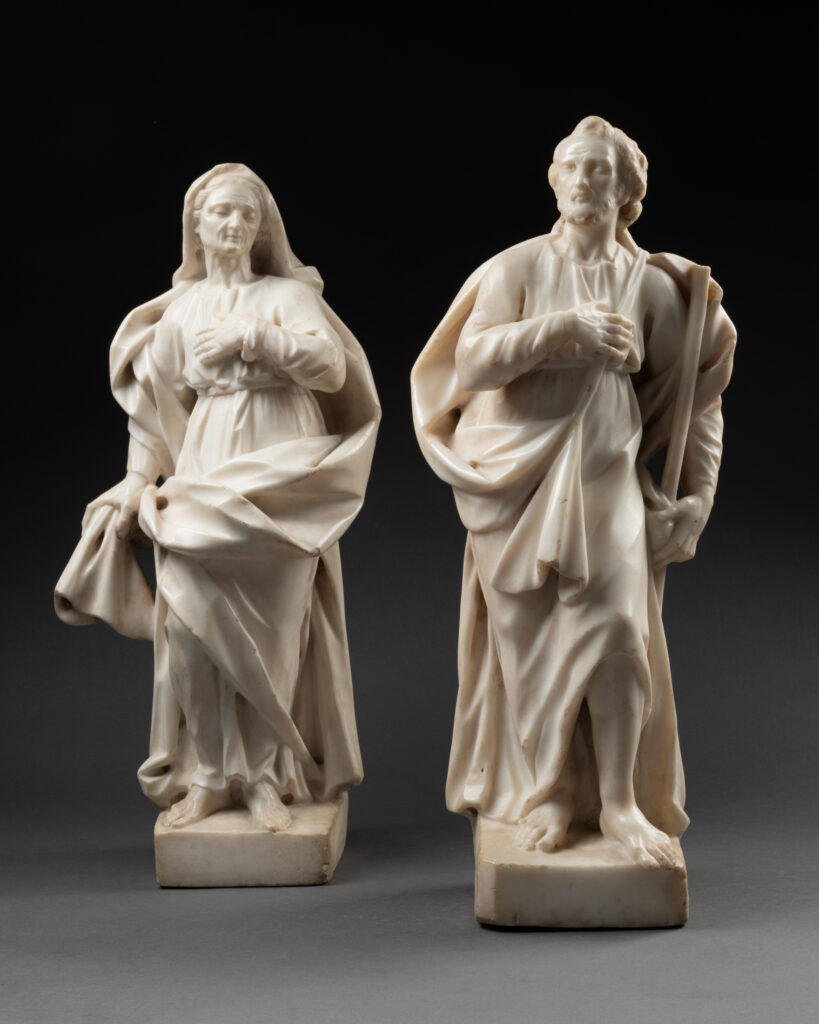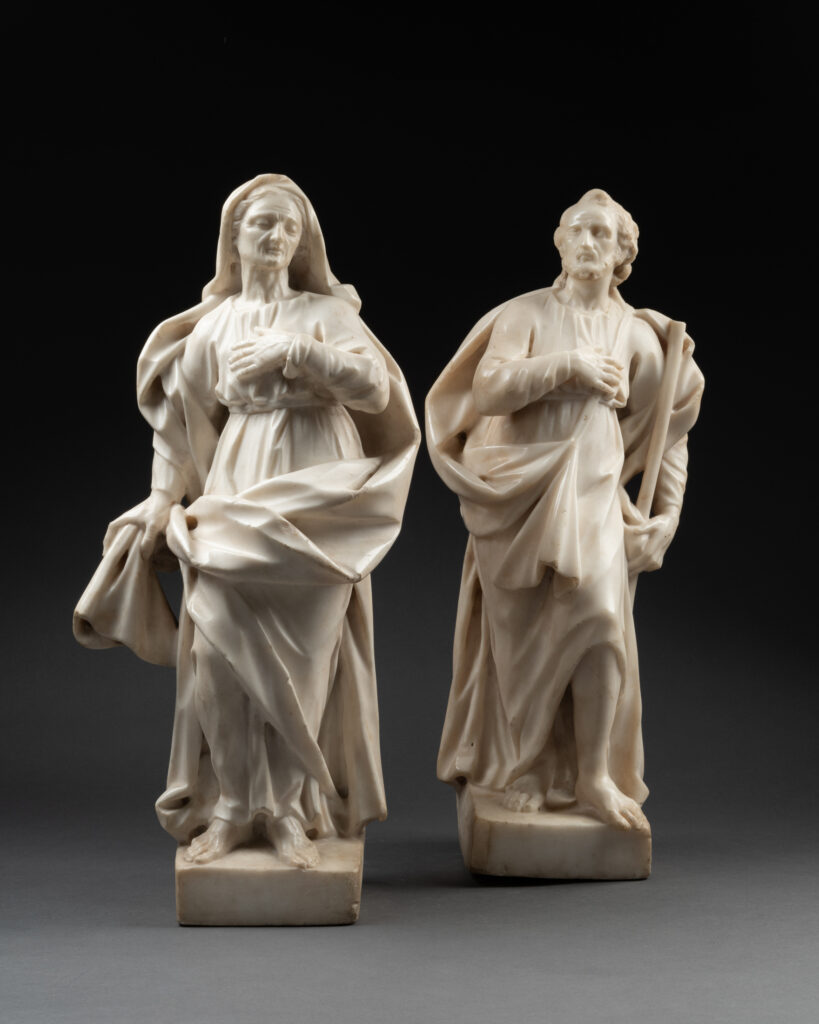This beautiful pair of marble sculptures represents Saints Anne and Joachim, parents of the Virgin. We can attribute it to the Paduan sculptor Jacopo Contieri and his workshop. This representation is absent from canonical biblical texts, the figures and the history of these saints come from the Greek apocryphal story of the Protevangelium of James, then from its Latin adaptation the Gospel of Pseudo-Matthew.
It is however in the XIIIth century, thanks to the propagation of the Golden Legend by Jacques de Voragine, that their image settles in the popular culture.
According to the texts, Anne, daughter of Akar and emeritus of the Tribe of Levi, was born in Bethlehem around 55 BC. She is described as a pious and long sterile woman. Her figure is often referred to, in the apocrypha, as her Old Testament namesake Hannah, mother of Samuel, prophet and last judge of Israel. Joachim goes back to the Royal Tribe of Judah, descending from the line of King David. Pious and charitable, he was a shepherd of sheep in Nazareth and later took care of his father’s flock near Jerusalem.
The accounts report that their meeting takes place in Jerusalem. Joachim regularly visited the Temple because he was in charge of its decoration. While washing his sheep in the pool of Bethesda, Hannah was near the Sheep Gate next door. After twenty years of marriage, the couple decides to separate because they are unable to give birth. Desperate for their situation which poses many problems in their religious and personal lives, they fast and pray on their own in the hope of being heard by God. Forty days later, an angel appears to them separately to tell them that they will soon be parents.
Their miraculous meeting at the Golden Gate, after the announcement of the upcoming birth of their child, is among the most popular representations of these two saints. In the 13th century, the legendary posterity of Saint Anne spread and resulted in the cult of the Holy Kinship, which also became a popular iconography of the holy parents of the Virgin, in opposition to that of the Holy Family. Their cult gradually declined in the 16th century in the territories affected by the Counter-Reformation. However, in Italy, Saint Anne and Saint Joachim continue to be represented and venerated. They are the patron saints of grandparents and the fertility of couples.
Their miraculous meeting at the Golden Gate, after the announcement of the upcoming birth of their child, is among the most popular representations of these two saints. In the 13th century, the legendary posterity of Saint Anne spread and resulted in the cult of the Holy Kinship, which also became a popular iconography of the holy parents of the Virgin, in opposition to that of the Holy Family. Their cult gradually declined in the 16th century in the territories affected by the Counter-Reformation. However, in Italy, Saint Anne and Saint Joachim continue to be represented and venerated. They are the patron saints of grandparents and the fertility of couples.
The artist of our saints also uses the trephine technique, a sort of drill bit operated by hand using a bow. This tool has been used since Antiquity to reach recesses, clear parts that are difficult to access and rough out small diameter grooves by forming cylindrical cavities. Slow but precise, the drill bit is intended for very fragile places and hard materials such as wood, stone and marble. The trephine technique brings movement and depth to the whole.
Mario Pintaric, professor at the University of Rijeka in Croatia, is a specialist in Italian sculpture. The latter carried out extensive research in order to attribute these sculptures to Jacopo Contiere and his workshop, this sculptor worked at the beginning of the 18th century and his style, particularly in the facial features, is similar to our work.
The statue of St Anne, although smaller in size, has obvious links with the statue of the same name in the Collegiate Church of Rijeka or that of the altar of the Assumption of Mary in the former Jesuit church of Ljubljana .
On the other hand, the physiognomy of Saint Joachim resembles that of Francis Xavier of Mošcenice.
Likewise, in sculpting Saint Joachim, Contieri repeats the usual pose of the character, as well as the way in which the drape is formed, which is also present on the sculpture of the same name in Moravca or Coseano.
The sculptures could have been part of one of the many dismantled altars in the Venice, Veneto and Friuli region. The statues could be placed on the altar or in the niches of the tabernacle. However, we cannot exclude the possibility that the sculptor made them for a private oratory.
Our two sculptures are therefore part of the production of late 17th century Italian Baroque with exaggerated movement, dramatic effects, tension in expression and a certain exuberance of forms, like the hand of Saint Anne whose size contrast with the rest of the body. As Philippe Beaussant said, the Baroque era was “a world where all opposites would be harmoniously possible”.
